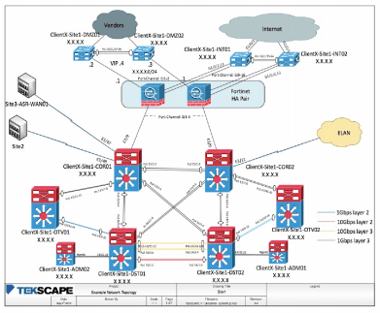A network diagram is defined as the graphic and visual representation of the network architecture. By using different symbols and line connections, you can see how every part of your infrastructure is tied together; this visual representation makes it easier for users to understand how items are connected. Is not always an easy process, and expert IT managed service firms will include this as part of their approach to managing your overall network.
Network Diagram: Visual representation of your network
 As these network diagrams include all the logical connections between every computer or system that are a part of your environment, they are extremely useful when tracking down a problem or when refreshing or updating your infrastructure. Given the myriad interdependencies in any given network, when you are facing a refresh project where one or multiple areas of the infrastructure will get updated, you need network diagrams to visually understand how a change in a silo will affect other connections in the entire environment.
As these network diagrams include all the logical connections between every computer or system that are a part of your environment, they are extremely useful when tracking down a problem or when refreshing or updating your infrastructure. Given the myriad interdependencies in any given network, when you are facing a refresh project where one or multiple areas of the infrastructure will get updated, you need network diagrams to visually understand how a change in a silo will affect other connections in the entire environment.
Unfortunately, more often than not, organizations will choose to replace old equipment with new without a thought for the overarching design. Thinking that new equipment is better when aiming to achieve a truly digital-ready network, and that the entire environment will be improved simply through the addition of it, is a terrible mistake to make.
Conducting a network refresh by just replacing hardware without a throughout consideration of the implications all the additional connections will have, is a mistake that can easily be solved by using network diagrams and having a fully understanding of network management.
Let me explain further...
Understand your existing design, then update!
A successful network refresh begins by understanding the business: What are the business goals? What are the critical business processes? And what technologies are essential in the IT business continuity plan? Once the business requirements are identified, it’s time to start looking at the limitations of the existing network and the problems it presented. Considerations such as capacity, performance, user experience and functionality have to be made and areas of improvement might be identified including connectivity, security, compute, storage and wireless in addition to the main networking systems.
Having a network diagram that reflects the existing design will then become the blueprint in which new technologies will be included. Establishing the overall connections and logical relations with existing parts of the environment will be helpful in building an implementation plan that considers risks and contingency plans.
The objectives here are:
- To keep the network backbone consistent, using centralized applications to push updates to all of your equipment at once.
- To identify technologies that can support future needs. As your business grows, your network needs to grow too. Performance demands need to be rapidly addressed to avoid any business disruption.
- To prevent any downtime due to new hardware being deployed and not able to connect with parts of the system.
- To identify any network vulnerability and establish a cybersecurity plan to monitor, detect and remediate any potential threat proactively.
As you can see network diagrams are critical for network refresh projects because they visually represent all the logical connections between each computer or system in your environment. They become the blueprint in which you can assess the overall effect a change or update in hardware can have in the performance of your network, helping you build an implementation plan that's consistent, guaranteeing little to none downtime.
As an experienced IT Managed Service Provider, we make a best practice of building a network diagram of the existing environment before jumping on any network refresh project. This has proven to be extremely helpful in considering technologies that are compatible with each other; flexible and scalable to meet business demands today and in the future, and highly secure to avoid any security breach that can disrupt the business. To learn more check out our Approach to IT Managed Services.
Proactive IT Managed Services
A proactive approach to IT managed services will give you peace of mind, your critical technologies and processes are constantly being monitored to detect any issues before they can cause any business disruptions. Partners like Tekscape have an approach with clear steps that add value, visibility and transparency into the management of your technology infrastructure.
Learn More about Tekscape’s Approach to Network Managed Services.





